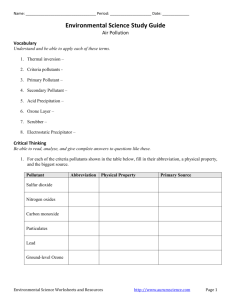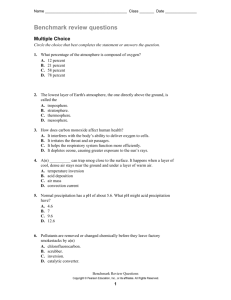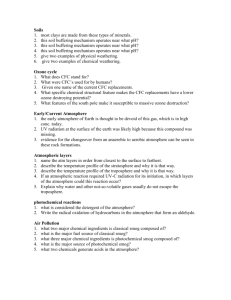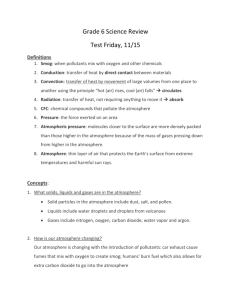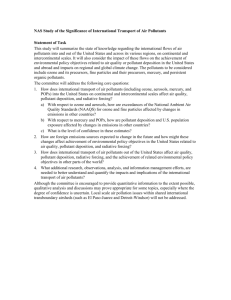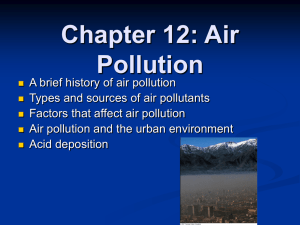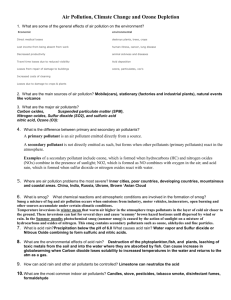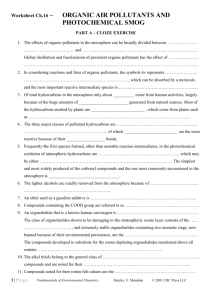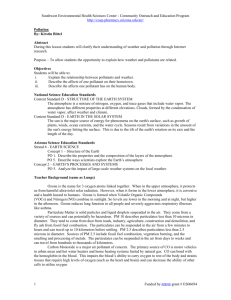The Atmosphere
advertisement
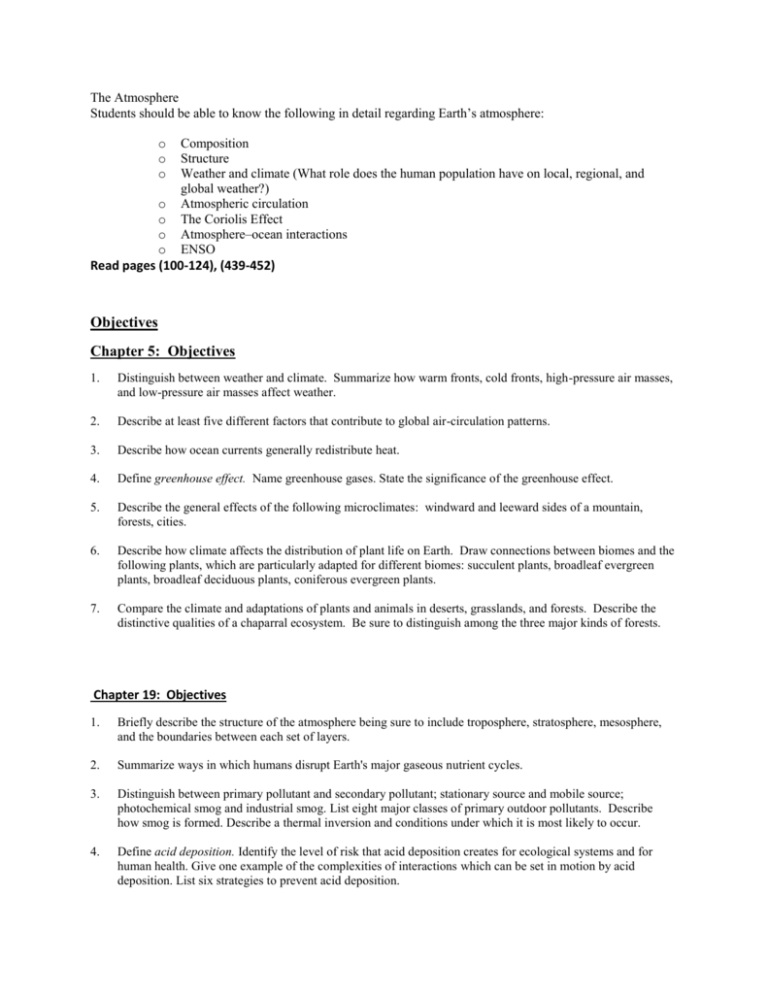
The Atmosphere Students should be able to know the following in detail regarding Earth’s atmosphere: o o o Composition Structure Weather and climate (What role does the human population have on local, regional, and global weather?) o Atmospheric circulation o The Coriolis Effect o Atmosphere–ocean interactions o ENSO Read pages (100-124), (439-452) Objectives Chapter 5: Objectives 1. Distinguish between weather and climate. Summarize how warm fronts, cold fronts, high-pressure air masses, and low-pressure air masses affect weather. 2. Describe at least five different factors that contribute to global air-circulation patterns. 3. Describe how ocean currents generally redistribute heat. 4. Define greenhouse effect. Name greenhouse gases. State the significance of the greenhouse effect. 5. Describe the general effects of the following microclimates: windward and leeward sides of a mountain, forests, cities. 6. Describe how climate affects the distribution of plant life on Earth. Draw connections between biomes and the following plants, which are particularly adapted for different biomes: succulent plants, broadleaf evergreen plants, broadleaf deciduous plants, coniferous evergreen plants. 7. Compare the climate and adaptations of plants and animals in deserts, grasslands, and forests. Describe the distinctive qualities of a chaparral ecosystem. Be sure to distinguish among the three major kinds of forests. Chapter 19: Objectives 1. Briefly describe the structure of the atmosphere being sure to include troposphere, stratosphere, mesosphere, and the boundaries between each set of layers. 2. Summarize ways in which humans disrupt Earth's major gaseous nutrient cycles. 3. Distinguish between primary pollutant and secondary pollutant; stationary source and mobile source; photochemical smog and industrial smog. List eight major classes of primary outdoor pollutants. Describe how smog is formed. Describe a thermal inversion and conditions under which it is most likely to occur. 4. Define acid deposition. Identify the level of risk that acid deposition creates for ecological systems and for human health. Give one example of the complexities of interactions which can be set in motion by acid deposition. List six strategies to prevent acid deposition. Vocabulary http://quizlet.com/30454615/apes-vocab-chapter-5-flash-cards/ Chapter 19 acid deposition The falling of acids and acid–forming compounds from the atmosphere to the earth’s surface. Acid deposition is commonly known as acid rain, a term that refers to the wet deposition of droplets of acids and acid–forming compounds. acid rain See acid deposition. air pollution One or more chemicals in high enough concentrations in the air to harm humans, other animals, vegetation, or materials. Excess heat is also considered a form of air pollution. Such chemicals or physical conditions are called air pollutants. See primary pollutant, secondary pollutant. atmospheric pressure Force or mass per unit area of air, caused by the bombardment of a surface by the molecules in air. EPA U.S. Environmental Protection Agency; responsible for managing federal efforts to control air and water pollution, radiation and pesticide hazards, environmental research, hazardous waste, and solid waste disposal. industrial smog Type of air pollution consisting mostly of a mixture of sulfur dioxide, suspended droplets of sulfuric acid formed from some of the sulfur dioxide, and suspended solid particles. Compare photochemical smog. inversion See temperature inversion. metropolitan area See urban area. nitrogen oxides (NOx) See nitric oxide and nitrogen dioxide. ozone (O3) ozone depletion Colorless and highly reactive gas and a major component of photochemical smog. Also found in the ozone layer in the stratosphere. See photochemical smog. Decrease in concentration of ozone (O3) in the stratosphere. See ozone layer. ozone layer Layer of gaseous ozone (O3) in the stratosphere that protects life on earth by filtering out most harmful ultraviolet radiation from the sun. PANs Peroxyacyl nitrates; group of chemicals found in photochemical smog. particulates Also known as suspended particulate matter (SPM); variety of solid particles and liquid droplets small and light enough to remain suspended in the air for long periods. About 62% of the SPM in outdoor air comes from natural sources such as dust, wild fires, and sea salt. The remaining 38% comes from human sources such as coal–burning electric power and industrial plants, motor vehicles, plowed fields, road construction, unpaved roads, and tobacco smoke. photochemical Complex mixture of air pollutants produced in the lower atmosphere by the reaction of smog hydrocarbons and nitrogen oxides under the influence of sunlight. Especially harmful components include ozone, peroxyacyl nitrates (PANs), and various aldehydes. Compare industrial smog. primary pollutant Chemical that has been added directly to the air by natural events or human activities and occurs in a harmful concentration. Compare secondary pollutant. secondary pollutant Harmful chemical formed in the atmosphere when a primary air pollutant reacts with normal air components or other air pollutants. Compare primary pollutant. smog Originally a combination of smoke and fog but now used to describe other mixtures of pollutants in the atmosphere. See industrial smog, photochemical smog. stratosphere Second layer of the atmosphere, extending about 17–48 kilometers (11–30 miles) above the earth’s surface. It contains small amounts of gaseous ozone (O3), which filters out about 95% of the incoming harmful ultraviolet radiation emitted by the sun. Compare troposphere. sulfur dioxide (SO2) Colorless gas with an irritating odor. About one–third of the SO2 in the atmosphere comes from natural sources as part of the sulfur cycle. The other two–thirds come from human sources, mostly combustion of sulfur–containing coal in electric power and industrial plants and from oil refining and smelting of sulfide ores. suspended particulate matter temperature inversion See particulates. Layer of dense, cool air trapped under a layer of less dense, warm air. It prevents upward–flowing air currents from developing. In a prolonged inversion, air pollution in the trapped layer may build up to harmful levels. thermal inversion See temperature inversion. troposphere Innermost layer of the atmosphere. It contains about 75% of the mass of earth’s air and extends about 17 kilometers (11 miles) above sea level. Compare stratosphere. urban area Geographic area containing a community with a population of 2,500 or more. The number of people used in this definition may vary, with some countries setting the minimum number of people at 10,000–50,000. volatile organic compounds (VOCs) Organic compounds that exist as gases in the atmosphere and act as pollutants, some of which are hazardous. Case Studies Summary 1. Key factors that determine the earth’s weather are short-term atmospheric conditions such as temperature, pressure, moisture content, sunshine, cloud cover, precipitation, wind direction, and wind speed. 2. Climate is a region’s long-term atmospheric conditions over decades. The two main factors in determining climate are average temperature and average precipitation. 3. The average climate—annual precipitation and temperature—determines terrestrial regions with characteristic types of natural ecological communities. According to these two factors, biomes form. 4. The major types of desert biomes are hot, temperate, and cold. Human activities have created large desert cities, destroyed soil through urban development and off-road vehicles, salinized the soil through irrigation, depleted underground water supplies, disturbed land and polluted, stored toxic and radioactive wastes, and located arrays of solar cells and solar collectors. 5. The three major types of grasslands are tropical or savannas, temperate grasslands, and polar grassland/tundra. The savannas have been destroyed by grazing cattle, which destroy vegetation and kills grass through fecal droppings. The temperate grasslands have been used to grow crops and graze animals. As a result, the grasslands have disappeared. The arctic tundra has been compromised by oil drilling, mines, and military bases. 6. The three main types of forest biomes are tropical, temperate, and polar/boreal. Human activities have destroyed much of the native trees; grazing has compromised the vegetation and eliminated food sources for native animals. And the deforestation has changed the tropical forest’s ecosystem, leading to death of plants and animals. The temperate forest has a fewer number of broadleaf trees and rich forest soil; but fires, logging, and hunting have undermined this type of forest. The evergreen firs of the polar forest support a variety of wildlife. But oil drilling and oil spills have compromised the water, the wildlife, and the vegetation in the arctic. 7. Mountain and arctic biomes play important ecological roles; they help regulate climate and effect sea levels. Mountain biome degradation arises from timber and mining extraction, from hydroelectric dams and reservoirs, from air pollution, increased tourism, and radiation from ozone depletion. 1. The layers of the atmosphere are the troposphere, stratosphere, mesosphere, and thermosphere. 2. Major classes of air pollutants include carbon, sulfur, and nitrogen oxides, volatile organic compounds, suspended particulate matter, photochemical oxidants, radioactive substances, and hazardous chemicals that can cause health problems. Primary sources of these pollutants include cars, industry, and natural phenomena such as volcanic eruptions. 3. The two types of smog are the photochemical and the industrial, or gray-air, smog. 4. Acid deposition includes wet deposition of acidic rain, snow, fog, and cloud vapor with pH less than 5.6, and dry deposition of acidic particles. Major sources of acid deposition are nitrogen oxides produced during fossil fuel combustion and sulfur oxides produced primarily from coal-fired power plants. 5. Harmful effects of air pollution include various respiratory diseases, premature deaths, damage to plants, and materials such as buildings, cars, statues, etc. 6. We can reduce air pollution by reducing emission through the use of low-sulfur coal, shifting to less polluting fuels (e.g., coal to natural gas), removal of pollutants after combustion or lower emissions through the use of mass transit or alternative transportation, improving fuel efficiency, and tax incentives.
